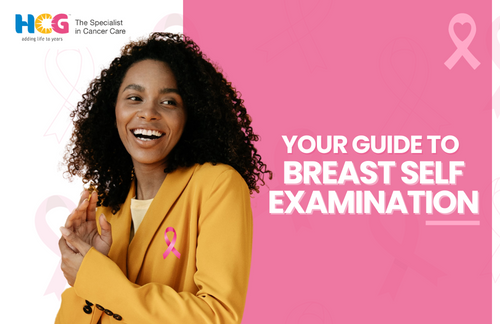
12 Nov, 2024

12 Nov, 2024

This article is medically reviewed by Dr. Tanay Shah, Consultant- Surgical Oncology and Breast Cancer Specialist, HCG Cancer Centre, Ahmedabad
Monthly breast self-examination (BSE) is a crucial practice that can help you stay ahead of breast cancer. While many women are familiar with breast self-examinations, some might still question if they are doing it correctly. Several women ask about how to check breast cancer at home.
This article provides all the information you need to know about conducting a proper breast self-examination.
Breast self-examination, or self-breast examination, is a simple breast cancer screening tool.
"Regular breast self-examinations are essential as they empower women to understand their bodies and
detect changes early. While not a replacement for mammograms, self-exams are crucial for early
detection, increasing the chances of successful treatment and better outcomes."
Dr. Tanay Shah
A breast self-examination involves a woman examining her breasts with her hands periodically at home in a systematic, stepwise fashion.
This helps women become familiar with the look and feel of their breasts and immediately notice when something is not normal. It also helps detect breast lumps that may or may not be cancerous.
Many are not aware of the importance of breast self-exams. Performing self-breast examination helps one in many ways. Most importantly, self-breast examination makes early detection of breast cancer possible.
The following are a few reasons why you should consider breast self-exams every month:
A self-breast examination should usually be performed at least once every month. The best time for breast self-examination is a few days after the menstruation cycle, when the breasts are least likely to be tender or swollen. Also, it is advisable to do it on the same day every month.
To make breast self-examination easy for you, we have broken down the entire procedure into five steps, and they are listed here. Please follow these breast self-exam steps every month.
Women should relax their arms on their hips and look at their breasts in the mirror. They should note the size, shape, and color of their breasts and examine them for any dimpling of the skin, swelling, or changes in the nipples.
Women should raise their arms above their heads and look for the same changes. This position allows women to view the lower and upper parts of the breasts more clearly.
Women should also observe any discharge from their nipples and any sign of fluid on their clothes. In the case of abnormal discharge from the nipples, note the color, consistency, amount, and smell of the discharge.
This step involves the breast physical examination. Women should lie down on their backs in a comfortable position. This position helps to spread the breast tissue evenly. Use of the left hand to examine the right breast and vice-versa is advisable.
They must then move their fingers in small circular motions to feel the breast tissue's surface, middle, and deeper layers. Later, they should gently squeeze the nipples to observe any discharge. A breast examination will be followed by an examination of the armpits and the upper chest for any lumps or unusual changes.
Performing a breast cancer self-exam while standing or sitting is an effective way to check for changes or abnormalities in the breast tissue. This position is particularly useful for examining the upper parts of the breasts and the areas near the armpits.
"For effective breast self-examinations, adhere to these steps: Observe your breasts in front of a mirror, lift your arms, inspect for discharge, palpate for lumps while lying down, and repeat while standing. Consistency and thoroughness are vital for early detection of any changes." Dr. Tanay Shah
It is important to note that not all breast lumps are cancerous. Breasts have a nodular or lumpy texture, which can vary based on age, hormonal changes, and individual anatomy. Lumps may occur due to fibrocystic changes, fibroadenoma, lobular carcinoma in situ, fat necrosis and lipomas, and cysts. The doctor should comprehensively evaluate any type of lump. It is important to know what abnormalities indicate the presence of breast cancer.
Women are advised to perform breast self-examination at least once every month, preferably a few days after their menstrual period. It is important to follow the recommended breast self-examination procedure during the examination to optimize the results.
The women should not ignore any of the symptoms of breast cancer or any other serious underlying disease detected during breast self-examination. It is important to seek care from a breast surgical oncology service provider in case women experience new or persistent lumps, nipple discharge, altered skin of the breasts, and pain in the breasts. Women, especially those who are at high risk, should consult the doctor to discuss the measures to reduce breast cancer risk.
Regular breast self-examination is a vital, non-invasive tool for early breast cancer detection, raising awareness of breast health, and improving overall quality of life. Conduct these exams monthly to familiarize yourself with your breasts and promptly detect any abnormalities. Always consult your doctor if you notice any unusual changes.
Breast Self-Examination - StatPearls - NCBI Bookshelf
Breast Self Exam | BreastCancer.Org
Breast Self-Exam | Nationalbreastcancer.org
Breast Cancer / Self Breast Examination | International Agency for Research on Cancer
Breast Self Exam | NHS Lanarkshire

Author Bio : Dr. Tanay Shah
MBBS, MS (General Surgery), DNB (Surgical Oncology)
Consultant – Surgical Oncology (Breast Cancer Specialist)
Dr. Tanay Shah is a seasoned surgical oncology consultant practicing at HCG Cancer Centre, Ahmedabad, a comprehensive cancer hospital in Ahmedabad. Dr. Tanay Shah specializes in the surgical management of breast, head and neck, gynecological, and GI oncological cancers. He is highly skilled in endoscopy including upper gastrointestinal tract endoscopy, colonoscopy, fiberoptic laryngoscopy, and bronchoscopy. His expertise has been recognized by his peers and he has participated in many oncology conferences and CMEs, which have significantly helped him hone his skills as a surgical oncologist.
To book an appointment with Dr. Tanay Shah, click here.